Panasonic Lumix DMC-FZ8
-
-
Written by Gordon Laing
Panasonic Lumix DMC-FZ8 sensor and image quality
Panasonic Lumix FZ8 features
Lenses / Screen and menus / Sensor and processing / anti-shake
The Panasonic Lumix FZ8 is equipped with a 7.2 Megapixel CCD sensor measuring 1/ 2.5in and delivering 4:3 aspect ratio images with a maximum resolution of 3072×2304 pixels.
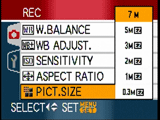 |
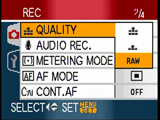 |
The FZ8 offers no fewer than five lower resolutions and the choice of two different JPEG compression levels, along with the very welcome addition of a RAW mode. It’s particularly impressive to find a RAW mode in a camera at this price point, and a sensible feature for Panasonic to include when rivals like Canon are controversially removing it from products like the higher-end PowerShot G7. Panasonic supplies the FZ8 with software for basic RAW conversions, or you can use third party programs – the FZ8’s RAW files are supported by Adobe Camera RAW version 4.0 onwards, although this requires Photoshop CS3.
The FZ8’s best quality JPEGs typically measure around 3MB each, while RAW files weigh-in at 11.3MB. There’s 27MB of internal memory to get you started, but like all cameras you should buy a memory card straightaway – like other Panasonics, the FZ8 takes SD memory and is compatible with SDHC cards for higher capacities.
The FZ8 also offers 3:2 and 16:9 aspect ratios, each available in two resolutions. Unlike the cunning sensor of the Lumix TZ3 though, the FZ8 simply crops horizontal bars from the top and bottom of its images to create these wider shapes. In 3:2 mode the maximum image size drops to 3072×2048 pixels, while in 16:9 it falls further to 3072×1728 pixels.
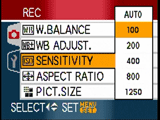 |
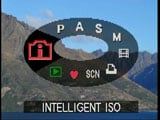 |
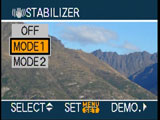 |
Sensitivity is adjustable between 100 and 1250 ISO, along with a 3200 ISO equivalent option in the High Sensitivity scene preset. In line with Panasonic’s latest compacts, the FZ8 features an Intelligent ISO setting on its mode dial which detects motion in the frame and can automatically increase the sensitivity to provide a sufficiently quick shutter speed to freeze it. In practice this actually works quite well and you can also set an upper limit for the ISO to maintain reasonable quality. There’s also a neat live demo mode which illustrates the FZ8 distinguishing between motion in the frame and camera shake.
Panasonic Lumix DMC-FZ8
colour and white balance
The FZ8’s white balance can be set to Automatic, Daylight, Cloudy, Shade, Flash, Halogen or one of two custom presets calculated by taking a reading from a specific subject. You can also manually fine-tune the white balance using a graphical plot.
Like other Panasonic cameras, the sharpness, contrast, saturation and noise reduction settings can be adjusted using the Pict Adj menu. Each can be set to Low, Standard or High, with the middle Standard settings used by default. These default settings delivered punchy, consumer-friendly photos out of the camera, although as you’ll see in our Results and Gallery pages, there’s visible smearing from noise reduction even at 100 ISO when images are viewed at 100%.
We repeated our real-life noise tests using each of the three noise reduction settings, although found smearing to be a problem even at the Low setting. This is only really noticeable when viewing images on-screen at 100% though, so while the FZ8 isn’t appropriate for pixel-peepers, its printed output looks fine.
Panasonic Lumix DMC-FZ8 exposure and creative options
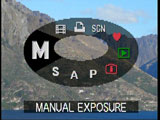 |
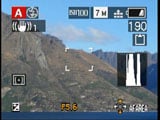 |
The Panasonic Lumix FZ8 offers shutter speeds from 1/2000 to 60 seconds (the longest via its starry sky scene preset) and ten aperture settings with the lens zoomed-out. Aperture and Shutter Priority, along with full Manual modes give you complete access to the settings, providing a decent degree of creative control. In each mode, the joystick on the back is used to select the desired setting and adjust it as required.
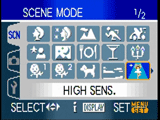 |
Like most non-DSLRs, the choice of apertures reduces at the fastest shutter speeds, and with the FZ8 the full aperture range of f2.8 to f8 is only available up to 1/1000. Increase the shutter to 1/1300 or 1/1600 and the maximum aperture falls to f4.0 and f5.6 respectively, while for the top speed of 1/2000, you’re fixed at f8. In our tests, the FZ8 delivered its sharpest images at f4 or lower.
For an easier life, the FZ8 also offers a wide array of scene presets: 20 in all, presented across two pages, consisting of Portrait, Soft skin, Scenery, Sports, Panning, Night portrait, Night scenery, Food, Party, Candle light, Baby 1, Baby 2, Pet, Sunset and High Sensitivity on the first page, followed by Starry sky, Fireworks, Beach, Snow and Aerial photo on the second.
Panasonic Lumix DMC-FZ8
continuous shooting
The Panasonic FZ8 offers three continuous shooting options: High, Low and Infinity. High and Low modes shoot at 3 and 2 fps respectively for a maximum of five best quality JPEGs or seven with greater compression. The infinity option keeps shooting at around 2fps while you have memory remaining. We set the FZ8 to its High mode and shot five best quality JPEGs in 1.8 seconds, corresponding to a rate of around 2.8fps.
Panasonic Lumix DMC-FZ8
Movie mode
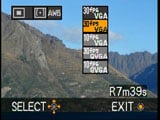 |
With the main mode dial set to the filmstrip icon, the FZ8 can record video clips in the Quicktime Motion JPEG format. The FZ8 can record in conventional 4:3 or widescreen 16:9 aspect ratios and at either 10 or 30fps.
Set to 4:3 the video resolution is either VGA 640×480 pixels or QVGA 320×240 pixels, while at 16:9 the FZ8 records a genuine widescreen WVGA mode of 848×480 pixels. Video recording is not supported on MMC memory cards – you’ll need to use SD cards or the built-in memory. Note if you are using the built-in memory though, the video resolution is fixed at 320×240 pixels.
Once you start recording, the focus, zoom and aperture value are fixed. Sadly you can’t optically zoom while filming, although optical stabilisation using Mode 1 is available. You’re looking at about 1.36MB per second of high resolution video at 30fps in either 4:3 or 16:9 aspect ratios. The video quality, like other Panasonic cameras, is very good with only a little tearing visible when panning. It’s also nice to switch the TV output aspect ratio to 16:9 and output anamorphic video ready to be stretched out to fill a widescreen TV.



